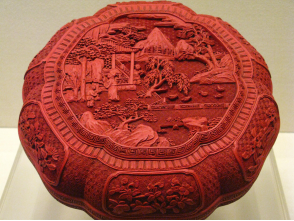
Lacquer (漆) art is a form of traditional art in China. It uses lacquer to paint on the surface of wares (器皿) or artwork. Lacquer comes from lacquer trees as a natural liquid. When you use lacquer for painting, it can stop wares from going bad. It can also resist high temperatures. If you heat the lacquer and add colors, it becomes colorful. Lacquer ware looks nice and it is also useful.
1.1.What does the underlined word “resist” probably mean in Chinese?
A 抵抗.
B 传播.
C 感染.
D 接受.
解析:选A。A 词义猜测题。根据划线单词前文的“it can stop wares from going bad”可知,此处讲的是漆的好处,可以防止器皿变质,也可以“抵抗”高温。故选A。
2.2.Lacquer ware was _______ in the Han Dynasty.
A rare
B useless
C common
D expensive
解析:选C。C 推理判断题。根据第二段中的“By the Han Dynasty, lacquer ware became part of everyday life.”可知,在汉代,漆器已经成为日常生活的一部分,即很常见。故选C。
3.3.When could lacquer furniture be found?
A In the Xia Dynasty.
B In the Han Dynasty.
C In the Song Dynasty.
D In the Ming Dynasty.
解析:选D。D 细节理解题。根据第三段中的“During the Ming and Qing Dynasties, lacquer ware making reached a new high. Lacquer techniques mixed with building and furniture making, focusing more on looks. ”可知,明清时期,漆艺与建筑和家具制作相结合,故推测那时已经有了漆器家具。故选D。
4.4.Which is not mentioned as a place for making lacquer ware?
A Pingyao.
B Yangzhou.
C Tianshui.
D Dalian.
解析:选D。D 细节理解题。根据第四段内容可知,现如今制作漆器的主要地方是北京、上海、重庆、山西平遥、江苏扬州、贵州大方、甘肃天水、江西宜春和陕西凤祥等地。并未提及大连。故选D。
5.5.In which part of a magazine can we read the passage?
A History.
B Culture.
C Geography.
D Science.
解析:选B。B 推理判断题。根据全文内容可知,文章主要介绍了中国非物质文化遗产之漆艺。故本文最有可能出现在“文化”版块。故选B。